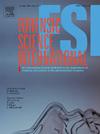Latent fingerprints (LFPs) are predominantly used for personal identification, but in recent years research has shown their potential for drug screening. Despite this there is no standardised collection method to allow accurate drug test interpretation. We sought to help address this by characterising different variables related to sweat deposition in LFPs as the knowledge is limited. A series of experiments were conducted firstly to validate a novel tool called the Ridgeway (Intelligent Fingerprint Ltd. UK) to quantify the amount of sweat deposited from a LFP using the refractive index (RI). A significant positive correlation was observed between the Ridgeway score (Rs) and LFP mass [r = 0.868, p < 0.01]. The Rs was used as means to investigate optimal sampling to characterise sample deposition for drug screening purposes. It was found with a consistent disposition pressure (300 – 400 g) and surface (glass slide) no significant difference was observed between the left and right index finger [left: p = 0.938; right: p = 0.838]. Significantly higher Rs [p<0.01] were obtained when 10 cumulative LFPs were deposited compared to a single LFP, suggesting a larger sweat quantity. We also wanted to investigate optimal eccrine sweat sampling to confirm drug ingestion over drug contamination of the fingerprint. We found that wearing gloves did not significantly improve mean difference in Rs when compared to no gloves [p = 0.239]. To produce eccrine only LFPs, external contamination (e.g. sebaceous sweat) needs to be removed. Soap with lint free tissue was significantly better for this compared to antibacterial hand gel [p<0.01]. Our findings showed that the Ridgeway tool effectively quantified LFPs at the point of deposition using a refractive index and enabled us to establish conditions for consistent LFP sampling.


